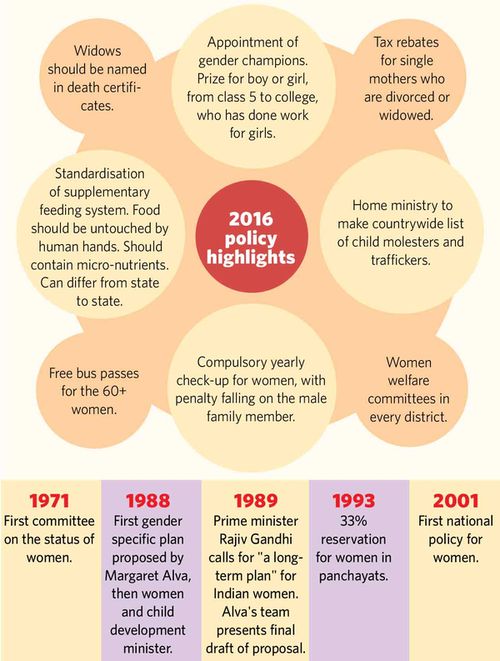Draft National Policy for Women 2016
Relevance: G.S paper I: Society and social Issues: Women Issues & G. S paper II: Polity and Governance: Welfare schemes for vulnerable sections of the population by the Centre and States and the performance of these schemes; mechanisms, laws, institutions and Bodies constituted for the protection and betterment of these vulnerable sections. • Issues relating to development and management of Social Sector/Services relating to Health, & Sociology: Social Changes in India: Constitution, law and social change. Challenges of Social Transformation:Violence against women.
INTRODUCTION
The policy is roughly based on the Pam Rajput Committee report set up by the MWCD in 2012 which submitted its recommendations last year, including a suggested national policy for women and an action plan to end violence against women.
What is the policy about?
- The draft is a comprehensive document which puts effort towards bringing a gamut of issues critical to the progress of Indian women and the ways in which they might be actualized.
- The policy envisions a society in which women attain their full potential and are able to participate as equal partners in all spheres of life.
- It also emphasizes the role of an effective framework to enable the process of developing policies, programmes and practices which will ensure equal rights and opportunities for women.
- The broad objective of the policy is to create a conducive socio-cultural, economic and political environment to enable women enjoy de jure and de facto fundamental rights and realize their full potential.
- The 24-page draft policy sets out a detailed plan of action for the mainstreaming of women in areas such as health, education, economy, governance and many others including: Bringing down India’s high maternal mortality rate, boosting nutrition for girls and women, protecting their reproductive rights, ensuring adolescent girls stay in school, improving child sex ratio, preventing female foeticide, eliminating gender wage gap, skill development, ensuring safety for women at home and outside, involving men and boys in gender sensitization efforts and many others.
-

Changing status of women in India:
- The status of women in the ancient Indian society was quite better. However, in the Middle Ages, the society became male dominated and acquired various ill practices and women were started to be treated as man’s slaves. They were forced to obey men blindly as a dumb cattle living under four walls of the house.
- At some place in the country, women are still ill treated by the men even after fast changes in the society. There has been a lot of improvement in the status of women in India after the independence and incorporation of various rights into the constitution.
- The discourse on women’s empowerment has been gradually evolving over the last few decades, wherein paradigm shifts have occurred –from seeing women as mere recipients of welfare benefits to mainstreaming gender concerns and engaging them in the development process of the country.
- These changes have brought forth fresh opportunities and possibilities for women’s empowerment while at the same time presenting new and emerging challenges which along with persisting socio-economic problems continue to hinder gender equality and holistic empowerment of women.
Why now?
- The policy is being revised after 15 years and is expected to guide Government action on Women’s issue over the next 15-20 years. Since last policy of 2001, there has been tremendous change in the attitude toward women and their expectations from life which requires legal backing to realize their rights and issues on ground.
- This policy shifts the focus from entitlements to rights and from empowerment to create an enabling environment for all strata of women.
Priority Areas
Health including food security and nutrition:
- There are 18 points under health, food security and nutrition which not only incorporates maternal and reproductive health but also the geriatric care, adolescent sexual & reproductive health and menopausal health care. The draft also acknowledges various challenges faced by women body since birth.
Education:
- This section suggests gender sensitisation of curriculum and faculty, and the use of ‘Gender Champions’ to promote gender sensitisation. The draft also creates a supportive environment by setting up a ‘responsive complaint mechanism’for sexual harassment and intimidation of girls and young women.
- Apart from these, the section also talks about enrolment and retention of adolescent girls in schools, innovative transportation models for better schooling outcome and addressing disparities with regard to ICTs.
Economy:
- In the discussion of women in the agricultural sector, the draft policy envisions for women the roles that they are now playing in Swayam Shikshan Prayog’sprojects, even using more or less the same kind of name, “Krishi Sakhi”. The draft also flags gender differentials in wages and gender-sensitive social security.
- The draft proposes a system of registration and “portability of entitlements such as ration cards and identity papers.” It also proposes the registration of tribal migrants by Panchayats, ostensibly to protect the rights of migrant tribal workers (and domestic workers), skill development and training for women, entrepreneurial development, review of labour laws and policies, equal employment opportunities with appropriate benefits related to maternity and child care services and address technological needs of women.
Governance and Decision Making:
- The draft policy mentions about increasing women’s’ participation in the political arena (through need-based training), in administration, in civil services and in corporate boardrooms as well as the skill development of women in traditional, new and emerging areas for independent decision making.
Violence against Women:
- The draft policy address all forms of violence against women through a life cycle approach, Legislations affecting /relating to women will be reviewed/harmonized to enhance effectiveness, Improve Child Sex Ratio (CSR), strict implementation of advisories, guidelines, Standard Operating Procedures (SoPs) and protocols, prevention of trafficking at source, transit and destination areas for effective monitoring of the networks.
- After all, the policy lists ‘violence’ under ‘priority areas’ that needs focus and work. It also enables government to look forward to help battle ‘violence faced by women in the private sphere of home, public spaces and at workplace’.
- However, the draft is silent on Marital Rape.
Enabling Environment:
- The draft mentions about Gender perspective in housing and infrastructure, ensuring safe drinking water and sanitation, gender parity in the mass media & sports, concerted efforts towards strengthening social security and support services for all women especially the vulnerable, marginalized, migrant and single women.
Environment and Climate Change:
- The policy talks about addressing gender concerns during distress migration & displacement in times of natural calamities due to climate change and environmental degradation. Promotion of environmental friendly, renewable, non–conventional energy, green energy sources for women in rural households.
Criticism:
- Critics have been grumbling that the draft policy is nothing but high sounding verbiage, describing it as a regurgitation of standard issue goals for the uplift of women, with no clear roadmap for implementing them.
- There is, for example, that old promise of 33% reservation of women in Parliament, a promise every government likes to make, but none delivers on.
- However, the biggest lacuna in the draft document is that it fails to refer to the problem of marital rape. The WCD Minister stated that Indian society was not ready to criminalise marital rape.
- The draft policy offered a chance to jettison this preposterous argument. But clearly, the government continues to turn a deaf ear to the cries of women who face this intolerable violence in their homes.
Conclusion:
- The Draft National Policy for Women is a step in the right direction providing backing hand to those Indian women who have been breaching one constricting social norm after another.
- In recent weeks and months the courts have struck down the bar on women’s entry into certain places of worship and upheld a single woman’s right to not have to reveal the name of her child’s father in a passport application.
- Change is in the air, slowly chipping away at patriarchy’s stranglehold on society. At a time like this, a 360 degree policy framework for women would not only consolidate the momentum of change, but also power it ahead.
- The policy gives hope to bridge the gap between ‘what is’ and ‘what ought to be’. But in order to make this reality, the central Government as well as state and civil society would need to work together. Every citizen of this country has a role to play in making it successful.
For more such notes, Articles, News & Views Join our Telegram Channel.
Click the link below to see the details about the UPSC –Civils courses offered by Triumph IAS. https://triumphias.com/pages-all-courses.php

